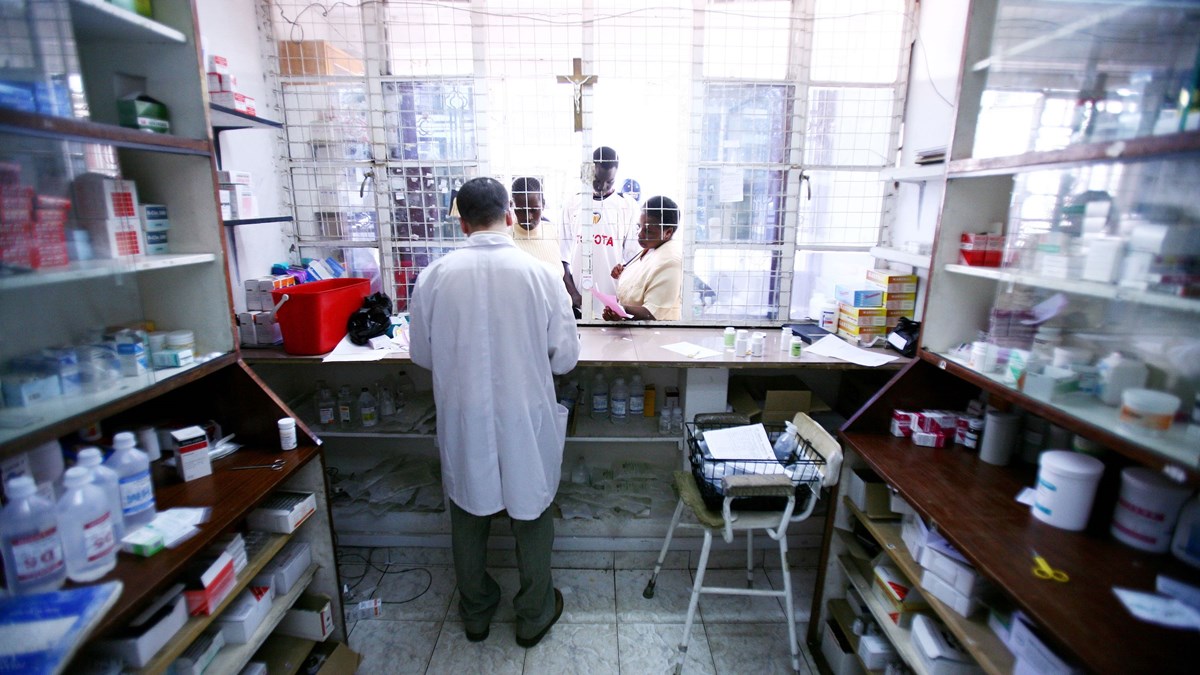PEPFAR Fight Worries African Christian Leaders
PEPFAR Fight Worries African Christian Leaders | News & Reporting ChristianityToday.com


African Christians Anxiously Await Reauthorization of PEPFAR

African Christians who have long worked against HIV/AIDS either in health facilities or in church ministry are anxiously watching the current AIDS fight in Congress, which will have direct effects on their programs on the ground.
Reauthorization of PEPFAR and its Impact on African Programs
The September 30 deadline is approaching to reauthorize the President’s Emergency Plan for AIDS Relief (PEPFAR), a US-funded HIV/AIDS program that is currently supporting 20 million patients on treatment, most of them in sub-Saharan Africa. US pro-life groups are opposing the five-year reauthorization on the grounds that the Biden administration has “hijacked” the program to provide and promote abortions as well as loosen African abortion laws. African faith-based providers say they have seen no evidence of that.
“We assure the United States Congress that the claim that PEPFAR supports or promotes abortion is to us strange, unfounded, and unfortunate,” wrote a group of 350 African church leaders, mostly evangelicals as well as some Catholics, in a Sept. 15 letter to Congress. “We would like to reassure you and the American public that we have seen no evidence that this is something that has ever happened.”
They urged the passage of the five-year reauthorization, saying that without it, “our people will be left in fear of the future.” The signers included pastors, heads of evangelical networks, and medical directors of Christian hospitals.
The Stalemate in Congress
Congress has reauthorized PEPFAR every five years since former president George W. Bush began the program in 2003, but this year, reauthorization appears unlikely by the deadline. This week more domestic pro-life groups announced their opposition to a multi-year reauthorization.
PEPFAR will keep its currently appropriated funding without reauthorization, so Congress has some time to make a deal. But a failure to reauthorize puts long-term health projects as well as certain features of the program in doubt. African health experts said it could have unpredictable consequences on the ground, like making patients worry that their life-sustaining drugs are going to be cut off.
Impact of PEPFAR on Health Facilities in Africa
Before PEPFAR began, Nkatha Njeru ran an HIV clinic at Nazareth Hospital, a historic mission hospital outside of Nairobi, Kenya. It was one of the early health facilities distributing antiretroviral drugs, which were expensive and hard to obtain at the time.
After the advent of PEPFAR, the drug prices dropped dramatically, and programs like Njeru’s were able to treat exponentially more patients. In the first year of receiving PEPFAR funding, the clinic scaled up from treating about 50 patients to about 1,200. “We’re not talking about ‘people living with HIV.’ It’s people that I can name,” she said.
She no longer runs the clinic, but she said the current fight in Congress makes her “very anxious.”
For 20 years, she said, patients have known they can go every month to pick up their drugs. Even a short gap in the drugs, which suppress viral load, would allow opportunistic infections.
“If [patients] don’t know if they will get the next dose, it’s going to cause panic as well,” she said. “And we don’t know what people will do—they might register in more than one clinic, just so that they can pile up drugs. And obviously that’s going to be disastrous.”
Pro-Life Groups’ Opposition to Reauthorization
More domestic pro-life groups announced their opposition to the five-year reauthorization this week. Americans United for Life, the March for Life, the National Right to Life, Catholic Vote, Students for Life of America, and the lobbying arm of Focus on the Family have joined The Heritage Foundation, Susan B. Anthony Pro-Life America, and the Family Research Council in opposing the multi-year reauthorization.
On Tuesday the groups articulated their position in a letter to congressional Republican leaders, saying that while they want PEPFAR to continue, Biden had “hijacked” PEPFAR “to promote abortion in African countries.” The groups called it “neocolonialism.”
Their argument reiterated arguments from Rep. Chris Smith, a Republican who had previously been a major advocate for PEPFAR but has long been frustrated that it was exempt from the Mexico City policy (except during the Trump administration). That policy prohibits federally-funded international groups from performing or advocating for abortion with separate resources.
The groups want reauthorization to include more pro-life restrictions like Mexico City. The bipartisan politics of PEPFAR have always been tenuous, but this is the biggest stalemate in its 20 years.
Clarification on Reproductive Health
In support of their position, the US pro-life groups cited a June letter from a different group of more than 100 African church leaders, mostly Catholic, who were concerned about PEPFAR promoting abortion. But the letter does not argue against reauthorization.
In that letter, leaders worried that PEPFAR was “supporting so-called family planning and reproductive health principles and practices, including abortion, that violate our core beliefs concerning life, family, and religion.” Pro-life groups usually understand “reproductive health” as code for abortion.
“We ask that PEPFAR remain true to its original mission and respect our norms, traditions, and values,” the June letter says.
The Biden administration has since clarified that “reproductive health” in the context of PEPFAR refers only to “HIV prevention, testing, and treatment services,” “education, testing and treatment for sexually transmitted infections,” cancer screening and treatment, and “gender-based violence prevention and care.”
“PEPFAR does not fund abortions,” the amended document from the administration reads.
Support for Reauthorization from African Faith-Based Organizations
Njeru, who ran the HIV clinic in Kenya, is now the CEO of
SDGs, Targets, and Indicators Analysis
1. Which SDGs are addressed or connected to the issues highlighted in the article?
- SDG 3: Good Health and Well-being
- SDG 5: Gender Equality
- SDG 17: Partnerships for the Goals
The issues highlighted in the article are directly connected to SDG 3, which focuses on ensuring healthy lives and promoting well-being for all at all ages. The article discusses the reauthorization of the President’s Emergency Plan for AIDS Relief (PEPFAR), a program that supports HIV/AIDS treatment in sub-Saharan Africa. This aligns with SDG 3’s target of ending the AIDS epidemic by 2030.
The article also touches on gender equality, as it mentions the concern of US pro-life groups that PEPFAR may promote abortions and loosen African abortion laws. This relates to SDG 5, which aims to achieve gender equality and empower all women and girls.
Lastly, the article highlights the importance of partnerships for achieving the goals. It mentions the collaboration between African faith-based providers and the United States Congress in addressing HIV/AIDS. This aligns with SDG 17, which emphasizes the need for global partnerships to achieve sustainable development.
2. What specific targets under those SDGs can be identified based on the article’s content?
- SDG 3.3: By 2030, end the epidemics of AIDS, tuberculosis, malaria, and neglected tropical diseases and combat hepatitis, water-borne diseases, and other communicable diseases.
- SDG 5.6: Ensure universal access to sexual and reproductive health and reproductive rights as agreed in accordance with the Programme of Action of the International Conference on Population and Development and the Beijing Platform for Action and the outcome documents of their review conferences.
- SDG 17.17: Encourage and promote effective public, public-private, and civil society partnerships, building on the experience and resourcing strategies of partnerships.
The specific targets identified based on the article’s content are:
- Target 3.3: Ending the AIDS epidemic by 2030, which is directly related to the reauthorization of PEPFAR and its support for HIV/AIDS treatment in sub-Saharan Africa.
- Target 5.6: Ensuring universal access to sexual and reproductive health and reproductive rights, which is indirectly addressed through the concerns raised by US pro-life groups regarding PEPFAR’s potential promotion of abortions.
- Target 17.17: Encouraging and promoting effective partnerships between African faith-based providers and the United States Congress to address HIV/AIDS, as mentioned in the article.
3. Are there any indicators mentioned or implied in the article that can be used to measure progress towards the identified targets?
- Indicator 3.3.1: Number of new HIV infections per 1,000 uninfected population, by sex, age, and key populations.
- Indicator 5.6.1: Proportion of women aged 15-49 years who make their own informed decisions regarding sexual relations, contraceptive use, and reproductive health care.
- Indicator 17.17.1: Amount of United States funding for programs in developing countries that leverage private sector investment and philanthropy.
The article does not explicitly mention specific indicators. However, based on the identified targets, the following indicators can be used to measure progress:
- Indicator 3.3.1 can be used to measure progress towards ending the AIDS epidemic by tracking the number of new HIV infections per 1,000 uninfected population.
- Indicator 5.6.1 can be used to measure progress towards ensuring universal access to sexual and reproductive health and reproductive rights by assessing the proportion of women aged 15-49 years who make their own informed decisions regarding sexual relations, contraceptive use, and reproductive health care.
- Indicator 17.17.1 can be used to measure progress towards effective partnerships by tracking the amount of United States funding for programs in developing countries that leverage private sector investment and philanthropy.
4. Table: SDGs, Targets, and Indicators
| SDGs | Targets | Indicators |
|---|---|---|
| SDG 3: Good Health and Well-being | Target 3.3: By 2030, end the epidemics of AIDS, tuberculosis, malaria, and neglected tropical diseases and combat hepatitis, water-borne diseases, and other communicable diseases. | Indicator 3.3.1: Number of new HIV infections per 1,000 uninfected population, by sex, age, and key populations. |
| SDG 5: Gender Equality | Target 5.6: Ensure universal access to sexual and reproductive health and reproductive rights as agreed in accordance with the Programme of Action of the International Conference on Population and Development and the Beijing Platform for Action and the outcome documents of their review conferences. | Indicator 5.6.1: Proportion of women aged 15-49 years who make their own informed decisions regarding sexual relations, contraceptive use, and reproductive health care. |
| SDG 17: Partnerships for the Goals | Target 17.17: Encourage and promote effective public, public-private, and civil society partnerships, building on the experience and resourcing strategies of partnerships. | Indicator 17.17.1: Amount of United States funding for programs in developing countries that leverage private sector investment and philanthropy. |
Behold! This splendid article springs forth from the wellspring of knowledge, shaped by a wondrous proprietary AI technology that delved into a vast ocean of data, illuminating the path towards the Sustainable Development Goals. Remember that all rights are reserved by SDG Investors LLC, empowering us to champion progress together.
Source: christianitytoday.com

Join us, as fellow seekers of change, on a transformative journey at https://sdgtalks.ai/welcome, where you can become a member and actively contribute to shaping a brighter future.







